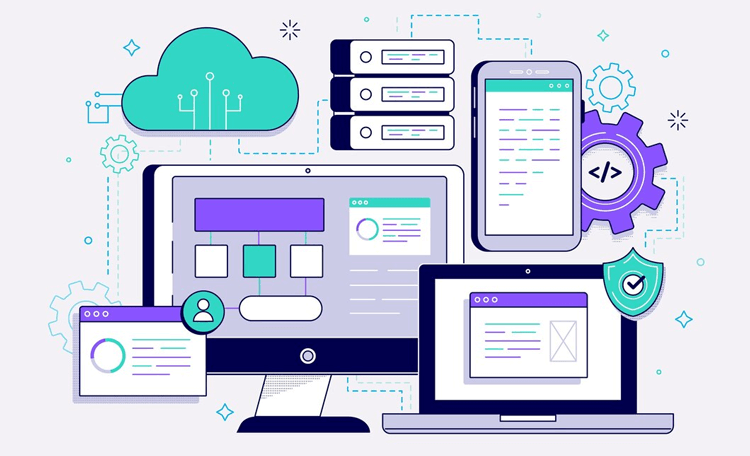How Software Development Contributes to Business Growth?
The digital environment in the modern world is changing fast. Software development for business has emerged as a critical component for different sectors. Any company desiring to maintain efficiency and competitiveness must invest in app development. The entire process is complex and involves designing software systems and coding. Designers must take time to test and invest in maintenance after launching the application.
Creating software for business has a wide range of uses. It aims to offer complex enterprise solutions and manage online platforms. Developers create different mobile apps to connect companies with clients. Business software development is important for every business sector.
Organizations use it to improve innovation and operational effectiveness. The software gives them the flexibility to adjust to changing customer expectations. Creating software helps businesses grow in different ways.
- The role of software in modern business
- Strategic planning and software development
- The relationship between software development and strategic planning
- Types of software for business
- Efficiency and finance
- Implementation of software in business
- Competitiveness, innovation, and future development prospects
- Challenges and coping strategies
- Conclusion
The role of software in modern business
The modern business environment requires software for different purposes. It is useful for improving productivity and driving expansion. Organizations build software to make it easier to adjust to changing market needs. The main goals of the software development business can be summarized as follows.

Optimization of staff work
Business software and app development lets companies streamline worker scheduling. Managers use these software and apps to measure employee productivity and calculate remuneration. These tools improve worker engagement and morale to work. It is useful for decreasing work costs while increasing visibility.
Increasing productivity
Optimization and automation of processes helps a lot. With them, managing workflows and organization becomes smooth. The software helps reduce distractions and multitasking. Streamlined workflows improve collaboration and work quality. Organizations benefit from productivity improvement.
Automation of business processes
Automation allows organizations to increase productivity and to have reliable networks. They use automation software to minimize errors and allow process scalability. Different departments save operational costs while enhancing customer experiences. The process of software development business is a complex one. It can be tougher for entrepreneurs who are planning to launch startups.
Startup software companies play an important role in this process. They provide customized business solutions designed to meet the needs of different business fields. Startups that are just launching or growing can benefit from experienced consultants. They can learn the types of software they need and scanning strategies as the business expands.
Strategic planning and software development
When startups and other businesses think about how to build software, the first consideration is planning. In this phase, the company sets goals for short-term and long-term development needs.
Analysis of business needs
In large or small business software development, understanding stakeholder needs is crucial. Organizations need to understand what customers require and what is useful for the business. These needs should be given a strategic form and should be included in company goals.
The development team looks at the software the business currently has. Based on a client’s business goals, they collect data to make an assessment of the future requirements which helps them work on their projects with a long-term approach.
Creating a software development strategy
A software development strategy defines the steps to follow from start to finish. The strategy works as the master plan for the entire process. The strategy may include the following.
- Defining the vision or goal of the software
- Understanding customer needs
- Creating software development goals
- Developing a strategic roadmap
- Involving development consultants
- Creating success measuring metrics
Recommended Blog for You:
👉 IT Industry: The Top 20 High Demand Skills for the Next 10 Years
👉 Things to Consider When Choosing a White Label Web Development Agency
👉 Top International SEO Tips and Tricks
👉 The Top 10 Productivity Tools You Need to Boost Productivity
👉 InboxPro Pricing, Reviews and Features in 2024
The relationship between software development and strategic planning
Business or startup software development cannot happen without strategic planning. Strategic planning allows organizations to set goals for application development. Planning is part of growth and involves many things. Creating software is a process that follows a systematic and well-planned roadmap so choosing a good company in this regard is important.

There are some prominent names in custom software development with DashDevs leading from the front. With support from DashDevs, the process becomes smooth. They offer a wide range of expertise useful for strategic planning – from understanding your requirements to designing a software and finally launching it within a particular timeframe.
Types of software for business
Companies develop software based on their needs. They look into their types of operations and create solutions that meet those needs. Some companies may create task management tools. Others may create customer relationship apps. Here are different types of software for business.
CRM systems
Organizations use CRM systems to manage customer data in a central place with the main idea to improve sales and marketing processes. The systems allow a wide range of integrations such as social media and calendars. They offer organizations all the solutions they need to serve their customers in the best way. They reach out to customers and provide them the best experience, which has a direct positive impact on retention rate.
ERP-systems
ERP systems allow companies to run all their operations with great success. The systems could be based in the cloud, hybrid, or within the premises. They allow automation, management, offering insights, and creating controls.
BI tools
BI tools collect large amounts of data and analyze it. The purpose is to offer organizations real-time business intelligence. They create visual reports that allow companies to see their position in the market.
Tax management tools
These are tools that help organizations manage taxes. They help companies calculate tasks accurately and submit them to the relevant authorities. There are many other important types of business software. They include:
- Project management tools
- File management applications
- Accounting apps
- Marketing software
- Programming applications
Efficiency and finance
The software development business should aim to offer a variety of solutions. It should aim to increase efficiency in business operations and service delivery. Beyond efficiency, it should help an organization save costs. To understand software impact, organizations need to cover analytics for e-commerce growth.
Financial benefits of using the software
The software allows enterprises to automate processes and save running costs. Some of the tools help with cost predictions and identifying revenue leakages. They increase efficiency, allow scaling, and streamline processes. Due to the use of software, companies get more financial benefits.
What determines the cost of software development and support
Several factors determine the cost of developing and supporting software creation. They include.
- Type of software and its complexity
- Time spent in the development processes
- Type of professional team or consultancy involved
- The kinds of technologies adopted for the processes
- Level of testing and maintenance needed
Indicators of the effectiveness of software use
Different metrics can help determine the effectiveness of software once it is launched. These include testing whether the software is serving the number of expected users. The speed at which the software works is also an important factor. Other factors include the stability of the code, cumulative flow, and performance without downtime.
ShopLentor- WooCommerce Builder for Elementor & Gutenberg
A versatile page builder to build modern and excellent online stores with more than 100k+ Active Installations.
Implementation of software in business
The implementation phase is the onboarding process of the software into the business system. Brands may do a one-time or step-by-step implementation.
Implementation plan and stages
The development team follows a systematic plan for launching the software. The team first describes the goals of the plan based on the current state of the company. Offering training to the users is also an important part of the process. The software is then launched and further training assessment is done. In the next stage, it goes through a testing period before it is made available to the public. Testing goes hand in hand with adjustments for improvements.
Staff training
Staff training takes place in phases. The first phase focuses on helping the staff to know the new system. The IT team may first provide the staff with all needed resources for the training. They need to choose the right training model including the timing and scheduling. Prioritize training based on the teams that will use the software most. Encourage engagement, allow failure, and receive feedback.
Monitoring of implementation and support at all stages
For early bug detection, security awareness and performance optimization, monitoring should be done across all implementation phases. The monitoring process should be based on the defined goals and objectives.
An easy way to do this is to establish Key Performance Indicator (KPIs) for each phase to measure success rate. An elaborate monitoring plan along with evaluation and monitoring tools enhances the process further.
Competitiveness, innovation, and future development prospects
The future of software development will be driven by AI. Soon, machine learning and AI will be critical in the entire development process. It will ensure the scaling of code quality and reduce the development time.
The impact of software on business competitiveness
Software development allows organizations to streamline their workflows. They optimize their processes and automate tasks. The end goal is to improve efficiency and productivity. The business gets a competitive edge and delivers its services quickly.
The role of innovation in software development and successful cases
Innovation allows development teams to try out ideas and test different processes. Testing out things leads to discoveries of unprecedented solutions. The team gets empowered to address challenges as they emerge. Innovations drive the business to stay ahead. It creates room for success and growth.
The impact of machine learning and artificial intelligence
Recent technological advancements like AI and ML have brought a revolution in software development. They allow scaling of productivity and application quality. AI minimizes the development and testing time by automating most processes. ML helps development teams predict defects. It helps them correctly allocate resources and identify bottlenecks with greater accuracy.
Challenges and coping strategies
Software development challenges include fast technological changes and growing customer needs. Resources and time including outsourcing could be major challenges. Brands need to have coping mechanisms in place.
Information security
Development teams may experience data breach challenges during development. These challenges include phishing, virus attacks, and ransomware challenges. The teams need to put in place online safety to protect data during development and afterward.
Software upgrade and compatibility
Challenges that come with compatibility include failure for system compatibility during launch. There could be data migration, user adoption, and cost constraint problems. To overcome such challenges, teams need to work closely with all stakeholders and ensure that the software has ample scope for future upgradations.
Changing the management culture
The management may lack an elaborate vision for the new technology. They may fail to help the rest of the team adopt the idea and work with it. This could create a wide gap between the development team and users. The company should allocate enough training resources for the users and also for the team. They need to upskill the team and ensure optimal awareness for the users with an aim to create a culture that adapts to change.
Conclusion
Software development promotes efficiency, creativity, and productivity. These are the main drivers of business growth. The strategic use of software solutions is a key component of long-term success for businesses. It helps companies to continually adapt to the changing digital landscape. Businesses that embrace the revolutionary potential of software development will be better equipped.
The development allows companies to prosper in a dynamic business environment which is usually full of new and complex challenges. If you are a business owner who is planning to implement custom software in any or all the processes and want to ensure a smooth journey from start to the end, we are sure this guide will help you a lot. The key lies in planning early and carefully.



